- Clone
- 41A (See other available formats)
- Regulatory Status
- RUO
- Other Names
- Terminal-Deoxynucleotidyl Transferase, DNA nucleotidylexotransferase, Terminal addition enzyme, Terminal transferase, DNTT
- Isotype
- Mouse IgG2a, κ
- Ave. Rating
- Submit a Review
- Product Citations
- publications
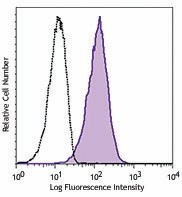
-

Human pre-B cell line REH was fixed and permeabilized with BioLegend's True-Nuclear™ Transcription Factor Buffer Set, and then stained with TdT (clone 41A) PE (filled histogram) or mouse IgG2a, κ PE isotype control (open histogram).
| Cat # | Size | Price | Quantity Check Availability | Save | ||
|---|---|---|---|---|---|---|
| 368803 | 25 tests | 113€ | ||||
| 368804 | 100 tests | 268€ | ||||
Terminal deoxynucleotidyl transferase (TdT), also known as DNA nucleotidylexotransferase (DNTT) or terminal transferase, is a member of the DNA polymerase type-X family and encodes a template-independent DNA polymerase that catalyzes the addition of deoxynucleotides to the 3'-hydroxyl terminus of oligonucleotide primers. TdT is a specialized DNA polymerase expressed early in pre-B and pre-T lymphoid cell development, and in acute lymphoblastic leukemia/lymphoma cells. TdT contributes to the generation of junctional diversity by synthesizing non-germ line elements (N-regions) at the junctions of rearranged Ig heavy chain and T cell receptor gene segments.
Product DetailsProduct Details
- Verified Reactivity
- Human
- Antibody Type
- Monoclonal
- Host Species
- Mouse
- Immunogen
- Recombinant full length human TdT
- Formulation
- Phosphate-buffered solution, pH 7.2, containing 0.09% sodium azide and BSA (origin USA)
- Preparation
- The antibody was purified by affinity chromatography and conjugated with PE under optimal conditions.
- Concentration
- Lot-specific (to obtain lot-specific concentration and expiration, please enter the lot number in our Certificate of Analysis online tool.)
- Storage & Handling
- The antibody solution should be stored undiluted between 2°C and 8°C, and protected from prolonged exposure to light. Do not freeze.
- Application
-
ICFC - Quality tested
- Recommended Usage
-
Each lot of this antibody is quality control tested by intracellular flow cytometry using our True-Nuclear™ Transcription Factor Staining Protocol.
- Excitation Laser
-
Blue Laser (488 nm)
Green Laser (532 nm)/Yellow-Green Laser (561 nm)
- Application Notes
-
NOTE: For flow cytometric staining with this clone, True-Nuclear™ Transcription Factor Buffer Set (Cat. No. 424401) offers improved staining and is highly recommended.
- Product Citations
-
- RRID
-
AB_2566320 (BioLegend Cat. No. 368803)
AB_2566321 (BioLegend Cat. No. 368804)
Antigen Details
- Distribution
-
pre-B and pre-T lymphocytes, malignant pre-B and pre-T lymphocytes.
- Function
- Catalyzes the addition of deoxynucleotides to non-germ line elements at the junctions of rearranged Ig heavy chain and T cell receptor gene segments and thus produces antigen receptor diversity.
- Interaction
- PCNA, LPTS-RP1, LPTS-RP2, histones H2A, H2B, H3, and H4.
- Ligand/Receptor
- This process doesn't need a complementary DNA template.
- Cell Type
- B cells, T cells
- Biology Area
- Cell Biology, DNA Repair/Replication, Immunology
- Molecular Family
- Enzymes and Regulators
- Antigen References
-
1. Yunk L, et al. 2009. J. Immunol. 183:452.
2. Kedzierska K, et al. 2008. J. Immunol. 181:2556.
3. Fuller SA, et al. 1985. Biochem. J. 231:105.
4. Feeney AJ, et al. 2001. J. Immunol. 167:3486.
5. Komori, T, et al. 1993. Science 261:1171. - Gene ID
- 1791 View all products for this Gene ID
- UniProt
- View information about TdT on UniProt.org
Related FAQs
- What type of PE do you use in your conjugates?
- We use R-PE in our conjugates.
Other Formats
View All TdT Reagents Request Custom Conjugation| Description | Clone | Applications |
|---|---|---|
| PE anti-human TdT | 41A | ICFC |
| APC anti-human TdT | 41A | ICFC |
| FITC anti-human TdT | 41A | ICFC |
| PE/Cyanine7 anti-human TdT | 41A | ICFC |
Customers Also Purchased
Compare Data Across All Formats
This data display is provided for general comparisons between formats.
Your actual data may vary due to variations in samples, target cells, instruments and their settings, staining conditions, and other factors.
If you need assistance with selecting the best format contact our expert technical support team.
-
PE anti-human TdT
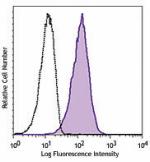
Human pre-B cell line REH was fixed and permeabilized with B... -
APC anti-human TdT

Human pre-B cell line REH was fixed and permeabilized with T... -
FITC anti-human TdT

Human pre-B cell line REH was fixed and permeabilized with T... -
PE/Cyanine7 anti-human TdT
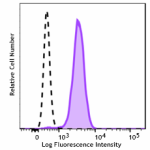
Human pre-B cell line REH was fixed and permeabilized with T...
 Login / Register
Login / Register 









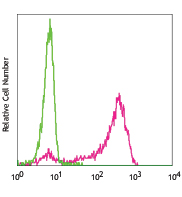
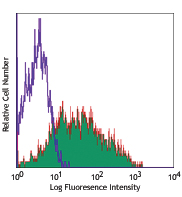

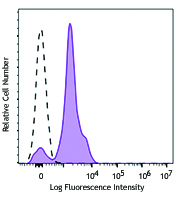



Follow Us